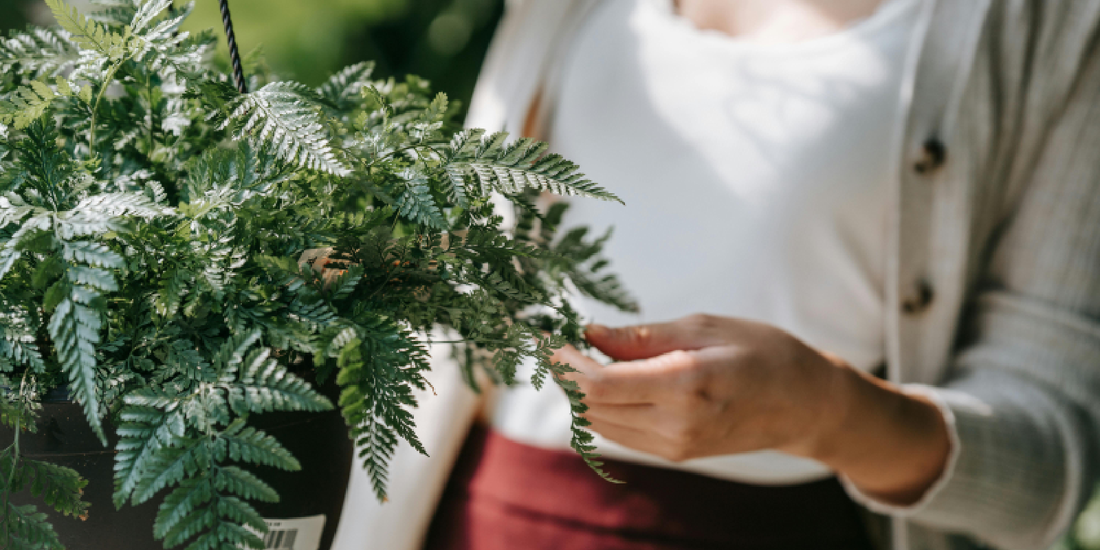
Growing Ferns Indoors: Light and Water Needs
Share
When it comes to indoor greenery, few plants are as timeless and graceful as ferns. With their delicate fronds and lush texture, ferns bring a sense of calm and natural beauty into any living space. However, growing ferns indoors requires more than placing them on a windowsill and hoping for the best. They thrive under specific conditions, particularly when it comes to light and water management.
At amoyls, we design plant solutions like the VerdantGlow S-Shaped 8-Tier Plant Shelf with Grow Lights to make indoor gardening easier, more sustainable, and visually appealing. Whether you’re a beginner or a seasoned plant enthusiast, understanding how to balance light exposure and watering routines will determine whether your indoor ferns remain healthy or struggle to survive.
In this guide, we’ll explore the essential light and water needs of indoor ferns, common mistakes to avoid, and practical ways to create an environment where ferns not only live but thrive.
Why Ferns Are Perfect for Indoor Spaces
Ferns have been around for over 300 million years, making them one of the oldest groups of plants still in existence. Their adaptability explains why they’ve become popular houseplants. With varieties like Boston Fern (Nephrolepis exaltata), Maidenhair Fern (Adiantum), and Bird’s Nest Fern (Asplenium nidus), these plants offer a range of sizes and leaf textures suited for apartments, studios, or large living rooms.
Beyond their aesthetics, ferns provide several benefits:
- Air purification – Many fern species are excellent natural air filters, improving indoor air quality.
- Humidity regulation – Their preference for moist environments helps balance dryness in air-conditioned or heated homes.
- Stress reduction – The soft, green fronds add a sense of calm and wellness to interiors.
To fully enjoy these benefits, you’ll need to pay careful attention to the balance between light and water.
Understanding Fern Light Requirements
1. Ferns and Natural Light
Ferns are naturally understory plants, meaning they evolved to grow beneath tall trees in forests. They are accustomed to dappled or indirect light rather than direct sun. Too much direct sunlight can scorch their delicate fronds, while too little light may cause slow growth or yellowing leaves.
Ideal placement for ferns indoors includes:
- North- or east-facing windows – These provide softer morning light.
- Filtered light through curtains – Prevents harsh rays while still offering brightness.
- Rooms with consistent ambient light – Bathrooms with frosted windows, kitchens, or shaded living rooms.
2. The Role of Grow Lights
In modern apartments where natural light may be limited, grow lights are often essential. A balanced full-spectrum grow light mimics natural daylight and ensures ferns receive the necessary wavelengths for photosynthesis.
The VerdantGlow S-Shaped 8-Tier Plant Shelf with Grow Lights is designed specifically for this purpose. Its integrated grow lights:
- Deliver consistent, balanced illumination.
- Offer height-adjustable shelves for ferns of different sizes.
- Eliminate the guesswork of whether your plant is receiving enough light.
For ferns, grow lights should be placed around 12–24 inches above the foliage and run for 12–14 hours daily, simulating a natural day cycle.
Watering Needs of Indoor Ferns
1. The Importance of Moisture Balance
If there is one golden rule for ferns, it’s this: Never let them dry out completely. Ferns require consistently moist soil but do not tolerate waterlogged roots. Striking this balance is crucial.
Signs of underwatering:
- Crispy, brown leaf tips.
- Drooping fronds.
- Soil pulling away from the edges of the pot.
Signs of overwatering:
- Yellowing fronds.
- Mushy roots with a sour smell.
- Mold or fungus on soil surface.
2. Best Practices for Watering
- Use room-temperature water to avoid shocking the roots.
- Check soil moisture by inserting your finger about 1 inch deep—if it feels dry, it’s time to water.
- Water thoroughly until liquid drains from the bottom, ensuring roots are evenly hydrated.
- Adjust frequency depending on the season—ferns need more water in summer and less in winter.
3. Humidity Needs
Ferns love humidity levels of 50–70%. Indoor air, especially in winter, often drops below this threshold. To maintain proper humidity:
- Mist the fronds lightly (avoid soaking).
- Place a pebble tray with water under the pot.
- Use a humidifier in particularly dry rooms.
- Group plants together to create a microclimate.
The amoyls VerdantGlow shelf makes this easier by organizing multiple ferns together, naturally increasing humidity in that zone.
Common Mistakes to Avoid
Even experienced plant owners sometimes make errors when caring for ferns. Avoid these pitfalls:
- Placing ferns in direct sunlight – Fronds scorch quickly.
- Letting soil dry out completely – Recovery is difficult once roots are stressed.
- Ignoring humidity – Dry air is one of the fastest ways to kill a fern indoors.
- Over-fertilizing – Ferns are light feeders; too much fertilizer burns roots.
- Using hard water – High mineral content can cause leaf spotting.
Pairing Ferns with Home Décor
Beyond their care requirements, ferns are versatile in styling. With their cascading fronds, they work well:
- On multi-tiered plant stands like VerdantGlow, creating a vertical green wall.
- In bathrooms, complementing tiles and mirrors.
- In offices, placed beside bookshelves or desks for a calming atmosphere.
- As corner fillers, where their soft texture balances hard furniture lines.
The VerdantGlow stand is particularly well-suited for ferns, as its S-shaped design allows light to reach every level, preventing lower plants from being shaded out.
Seasonal Care Adjustments
- Spring and Summer – Active growth phase; water frequently, fertilize lightly with a diluted balanced fertilizer.
- Autumn – Gradually reduce watering; trim old fronds.
- Winter – Monitor humidity closely; ferns may need supplemental light.
By making small seasonal adjustments, you’ll keep your ferns strong year-round.
Choosing the Right Ferns for Indoors
Not all fern species adapt equally well to indoor conditions. Some excellent choices include:
- Boston Fern – Classic and hardy.
- Maidenhair Fern – Elegant but requires high humidity.
- Bird’s Nest Fern – Tolerates lower light, ideal for beginners.
- Staghorn Fern – Unique appearance, often mounted on walls.
Final Thoughts
Growing ferns indoors is deeply rewarding. By providing the right light and water balance, you can transform your living space into a lush, tranquil retreat. With tools like the amoyls VerdantGlow S-Shaped 8-Tier Plant Shelf with Grow Lights, it’s easier than ever to create the perfect indoor environment for your ferns.
Healthy ferns are more than plants—they’re companions that bring life, serenity, and timeless beauty into your home.
